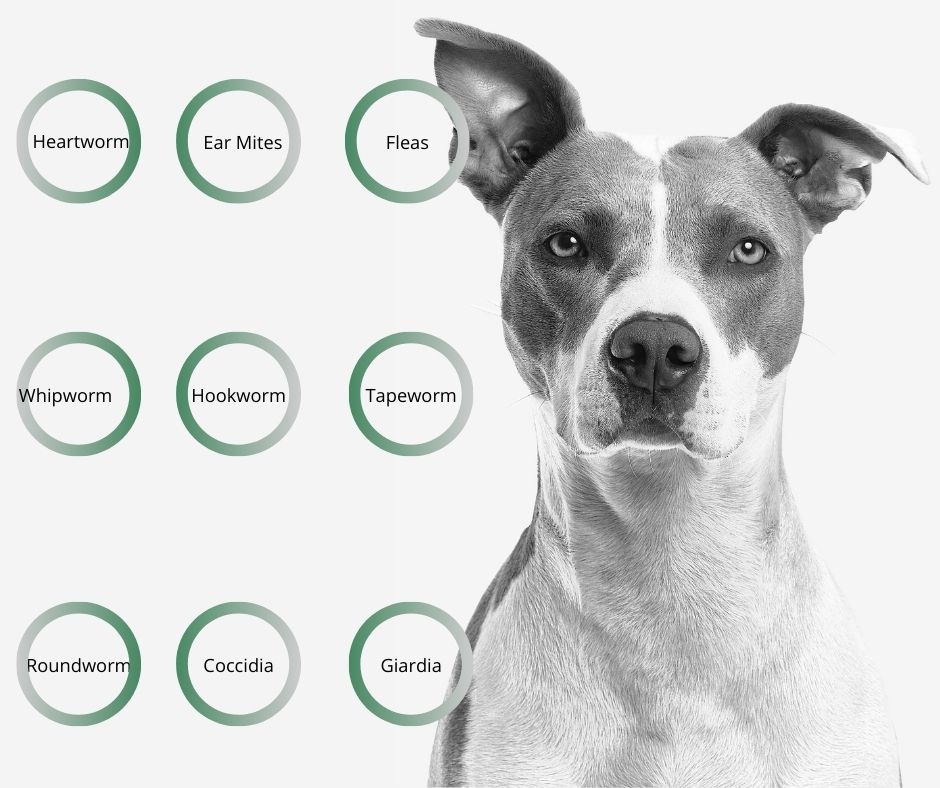Parasites
Puppies and kittens can often carry a parasite burden. It is important to treat these early on and then continue regular prevention throughout your pets life. Below are the more common parasites seen in our area.

Heartworm disease is a serious and potentially fatal disease in pets in the United States and many other parts of the world. It is caused by foot-long worms (heartworms) that live in the heart, lungs and associated blood vessels of affected pets, causing severe lung disease, heart failure and damage to other organs in the body. Heartworm disease affects dogs, cats and ferrets, but heartworms also live in other mammal species, including wolves, coyotes, foxes, sea lions and—in rare instances—humans. Because wild species such as foxes and coyotes live in proximity to many urban areas, they are considered important carriers of the disease.
Whipworm are 45–75 mm long and consist of a long, slender anterior portion and a thick posterior third. They commonly inhabit the cecum and colon of dogs, where they are firmly attached to the wall with their anterior end embedded in the mucosa. Thick-shelled eggs with bipolar plugs are passed in the feces and become infective in 1–2 mo in a warm, moist environment. Although eggs may remain viable in a suitable environment for up to 5 yr, they are susceptible to desiccation. The life cycle is direct. After infective eggs are ingested, the larvae hatch and develop in the wall of the distal ileum, cecum, and colon, and the adults mature in ~11 wk. They may remain for up to 16 mo.
Ear mites spread rapidly, and can be transmitted from even brief physical contact with other animals. In pets, ear mites most commonly affect cats, ferrets, and to a lesser extent dogs. Humans can rarely be infected with ear mites. Infected animals have a large amount of crumbly dark brown material in their ears. On close inspection, tiny white mites can barely be seen in the debris, as they are microscopic. Ear mites do not burrow as some mites do, but live within the ear canal.
Roundworms are the most common of the parasitic worms found inside a dog. Almost all dogs become infected with them at some time in their lives, usually as puppies. Roundworms may be contracted in different ways, making them easy to spread and hard to control. Your dog may be infected with roundworms from the time it is born because often the mother passes the worms to the puppy while it is still in her body. Roundworms can also develop in a puppy after it is born when the puppy eats larvated eggs from the environment or drinks worm larvae (young worms) in the mother’s milk. Another way roundworms are passed is when roundworm larvae are present in the tissues of a mouse or another small mammal and the puppy eats the animal.
Hookworms—along with roundworms and whipworms—are among the “unholy trinity” or infectious agents in dogs. For many reasons, including persistence of infectious stages in the environment and zoonotic potential (i.e., larva migrans), it is advantageous to prevent these parasitic infections and the resulting contamination in the soil. hookworms attach to the small intestinal mucosa, after which they will suck blood—lots of blood. The primary cause of pathology and clinical disease from hookworms is blood loss. Hookworms can infect humans. The most well-known form of infection is cutaneous larva migrans, commonly known as “creeping eruption.”
Pets can get tapeworms by swallowing a flea infected with a tapeworm larvae. A dog or cat may swallow a flea while self-grooming. Once the flea is digested by the dog or cat, the larval tapeworm is able to develop into an adult tapeworm. Weight loss may occur if your pet is heavily infected. Sometimes, an infected dog will “scoot” or drag its anus across the ground or carpet because the segments are irritating to the skin in this area. Occasionally, a portion of this tapeworm will be passed when the dog vomits. If this happens, a worm several inches long may be seen.
A flea is a blood-feeding parasite that goes from host to host. Once your pet has fleas, it can take at least 3 months (sometimes longer) to break the lifecycle and get rid of the problem. That is why rear-round prevention is recommended.
Coccidia is a single-celled organism that lives in the intestinal tract. Your dog can become infected with coccidia from swallowing oocysts (immature coccidia) that are found in dog feces and soil contaminated with feces. Infected dogs pass oocysts in the feces. These oocysts are very resistant to a wide variety of environmental conditions and can survive for some time on the ground. Under the right conditions of temperature and humidity, these oocysts ‘sporulate’ or become infective. If a susceptible dog ingests the sporulated oocysts, the oocysts will release ‘sporozoites’ that invade the intestinal lining cells and set up a cycle of infection in neighboring cells. Dogs may also become infected indirectly by eating a mouse that is infected with coccidia.
Giardia is typically picked up by a dog ingesting it into its system. Typically, this will occur when a dog eats something or drinks something that has been contaminated with fecal matter. The offspring of this parasite are shed in animal feces. The most common method of infection is waterborne because the parasite prefers a cool, moist environment. Giardia can survive in these conditions for up to several months. Dogs may also become infected by ingesting infected fecal material directly. Giardiasis is more common among young animals and those confined in groups, such as in kennels or boarding facilities. Once your dog has ingested giardia, the mature parasites known as trophozoites infect the small intestine. They grow, multiply, and are passed in the feces. Which allows the parasite to spread from animal to animal and can even be passed to people.
